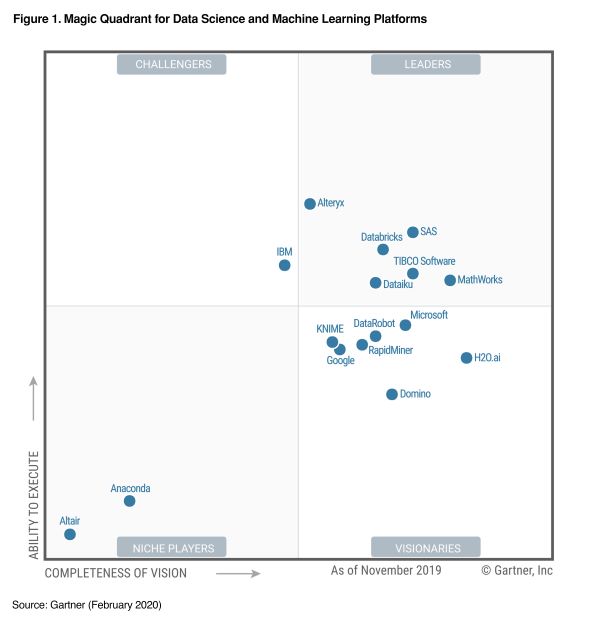MathWorks Is a Leader in the Gartner Magic Quadrant for Data Science and Machine Learning Platforms 2020
This is a guest post from Paul Pilotte, technical marketing manager for AI, data science and deep learning.
We’re pleased to have been named a "Leader" by Gartner this year, with the furthest placement for "completeness of vision" of all the Leaders in the quadrant. Last year, Gartner recognized MathWorks as a "Visionary", so in our opinion this move into the Leaders quadrant shows strong progress.
I wanted to share this news and talk about how, as a key player in the AI landscape, MathWorks thinks differently about AI.
AI continues to be a strategic priority for many companies. We certainly see this in the growing number of complex projects we’ve helped our customers complete in the past year, and we expect this trend to continue. See these pages for examples of how customers are using MATLAB for deep learning and machine learning.
We’re seeing AI projects expand to include applications across image processing, computer vision, signal and audio processing, robotics, and control systems. The engineering and operations teams we work with are using MATLAB to incorporate AI across the entire system design workflow. Success in developing AI-enabled systems requires more than training an AI model: You also need high-quality data, engineers and scientists focused on AI, and an understanding of the complete AI workflow.
 We believe our recognition as a Leader in Gartner's 2020 Magic Quadrant for Data Science and Machine Learning demonstrates our ability to help organizations:
We believe our recognition as a Leader in Gartner's 2020 Magic Quadrant for Data Science and Machine Learning demonstrates our ability to help organizations:
 We believe our recognition as a Leader in Gartner's 2020 Magic Quadrant for Data Science and Machine Learning demonstrates our ability to help organizations:
We believe our recognition as a Leader in Gartner's 2020 Magic Quadrant for Data Science and Machine Learning demonstrates our ability to help organizations:
- Equip teams with limited AI or data science skills as well as those with advanced skills to apply AI successfully
- Incorporate AI across the complete system design workflow including data preparation, analytics and modeling, simulation and test, and production
- Deploy AI models on embedded devices, edge, enterprise systems, and the cloud
- Use Simulink to tackle system design, integration, and validation challenges when developing AI-driven systems
- Automate labeling data including images, videos, signals, and audio recordings
- Graphically design and analyze deep learning using the Deep Network Designer app
- Build advanced network architectures like GANs, Siamese networks, attention networks, and variational autoencoders
- Import and export models with other deep learning frameworks (such as TensorFlow and PyTorch) using the ONNX model format
- Train reinforcement learning policies to implement controllers and decision-making algorithms for complex systems such as robots and autonomous systems
- Automate deployment of inference models to CPUs, GPUs, and FPGAs.
- Get Ready for AI with MATLAB
- MATLAB for Deep Learning
- MATLAB for Machine Learning
- MATLAB for Data Science
- MATLAB for Enterprise and IT Systems
- Category:
- Deep Learning









Comments
To leave a comment, please click here to sign in to your MathWorks Account or create a new one.